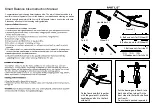
21
TIP – get an extra pair of hands to help with this. Make sure that any links
you alter with the chain link remover are not stiff on the rivets. If in doubt,
remove fewer links than you think as removing links is easier than riveting
links back in. Use the quick disconnect link to open the chain and then
punch out links and quick connect back together.
When you've finished adjusting the chain length, check at the pulley plate where the chain enters and leaves
the chain tubes. The plastic clips should be adjusted vertically so the chain is running centrally where it enters
and exits the chain tubes. This is also the position where the chain runs at it quietest.
2.17 Check the gear shifting
While pedalling, shift the chain up and down the chainrings several times to take out initial slack in the cables.
Any slack can be removed by adjusting the barrel adjuster on the shifters.
Shift the chain to the smallest rear cog. While turning the pedals, move the shifter up 1 click, to the “8”
position. If the chain hesitates or does not shift to the second cog, increase the cable tension by turning the
shifter barrel adjuster counter clockwise. If the chain shifts beyond the second cog, decrease the cable
tension by turning the shifter barrel adjuster clockwise.
Repeat the two former steps until shifting and cable tension is accurate.
It is not enough that the chain should run quietly in each gear, it should also move smartly from one sprocket
to the next, without clattering or jamming.
Now check for smooth changing up through the range, checking one pair of sprockets at a time (8-7, 7-6, etc.)
Make any minor adjustments by turning the shifter barrel adjuster. Finally, check that the chain cannot jump
off the cassette, either on the inside into the spokes, or on the outside onto the dropout. This is adjusted
using the high and low limits screws as shown in the manufacturer’s supplied instructions.
Cut the cable off leaving about 3” (75mm) past the cable clamp, and crimp the cable end cover onto the cable
end.






































